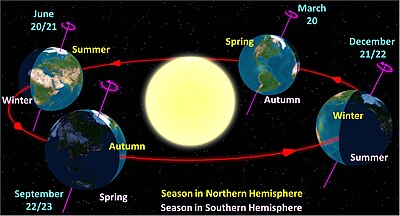Astrodynamics/The Earth
The Earth is an object of special importance, not because it has any special characteristics, but because it is our starting point. All satellites that we launch start on the surface of earth, and all our observations are made from its surface. The only exception to the second rule is that some observations are made from satellites that have been previously launched from earth. Most of the practical applications of astrodynamics are centered around the earth (orbiting satellites, ballistic missiles, etc.), and so we will focus much of our attention on it.
Size and Shape
[edit | edit source]Generally, it is thought that the Earth has a spherical shape. One of the most prominent reasons for this is that whenever we do calculations based on it, we approximate it to a sphere having a radius of approximately 6300 km. This is also further exacerbated by the fact that pictorial representations of the Earth such as The Blue Marble show it to be a sphere. However, the Geodetic data shows Earth to be more of an Oblate Spheroid. The Oblateness refers to a bulge at the equator, which is termed as the Equatorial bulge and is caused by the centrifugal force of the Earth's rotation around its own axis. This means that the diameter across the Equatorial plane is more than 42 kilometers longer than the diameter at the poles.
Orbit and Rotation
[edit | edit source]One earth rotation on its axis, such that the sun is at the same place in the sky, is known as a solar day. A solar day is 24 hours by definition.
The period of the Earth's rotation is known as a solar year. A solar year is equal to 365.25 solar days.
The Earth's orbital plane is not parallel with the Earth's equator. This tilt in the orbital plane causes the seasons.

Equinoxes
[edit | edit source]When the sun appears directly over the equator, and the day is the same length as the night, it is called the equinox. The equinox between the months of March and April is known as the vernal equinox. The autumnal equinox is the transition between the months of September and October.
Solstices
[edit | edit source]When the sun appears at its highest or lowest point in the sky at the equator, it is called a solstice. Summer solstice is when the day's length is at its longest and winter solstice is when the day's length is at its shortest. The solstices for the northern and southern hemisphere are opposite because of the earth's tilt, meaning that summer solstice in the northern hemisphere is winter solstice for the southern hemisphere and vice versa, this is because the sun's position in the sky is different for both hemispheres.
Equatorial Plane
[edit | edit source]The Earth's equator is a circle. The plane containing this circle is the equatorial plane. To someone standing on the surface of the Earth, this plane is everything that is at right angles from the north (or south) celestial pole. If they are standing at Earth's north (or south) pole, then the points in the direction of the horizon are on the equatorial plane.
Canonical Units
[edit | edit source]The distance between the earth and the sun can be difficult to measure, and the units involved can make calculations difficult. However, we can define a new unit, the astronomical unit (AU) that is the average distance between the earth and the sun. 1 AU = 149 597 870.691 km.
